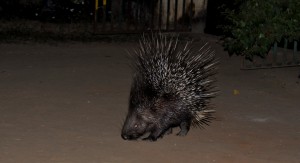Kamo, the prickly porcupine
Meet Kamo the porcupine, the lovable, but ‘prickliest’ of all rodents, which even predators fear. Komo is so-called as he/she ‘kums’ when called..”kamo, kamo, kammoo”. And who calls her? Forest staff at a chowki in Sariska Tiger Reserve, Rajasthan. Forest staff posted in the remote stations forest s lead a lonely life away from family, friends, TV, Facebook (well, most stations don’t have electricity). And many a time, you will find that they have ‘befriended’ animals. Mostly some orphaned or ‘rescued’ (from villagers, from the bazaar, hunters etc) cheetal or sambhar fawn. They are never really tame (rather just familiar), but cocooned here, from the life in the jungle, where they now couldn’t possibly survive. I met a baby chink in Desert National Park (she liked the camera lens for some reason and would follow whoever had it. I have one pic of her somewhere tailing me, nosing the lens like a little lamb); while at Velvadar a skittish blackbuck hung around the rest house. It had a one-track mind: Food)
s lead a lonely life away from family, friends, TV, Facebook (well, most stations don’t have electricity). And many a time, you will find that they have ‘befriended’ animals. Mostly some orphaned or ‘rescued’ (from villagers, from the bazaar, hunters etc) cheetal or sambhar fawn. They are never really tame (rather just familiar), but cocooned here, from the life in the jungle, where they now couldn’t possibly survive. I met a baby chink in Desert National Park (she liked the camera lens for some reason and would follow whoever had it. I have one pic of her somewhere tailing me, nosing the lens like a little lamb); while at Velvadar a skittish blackbuck hung around the rest house. It had a one-track mind: Food)
Our Kamo was no ‘pet’, a very wild creature she/he had this uncanny habit of materialising during dinner time. He (i assume) kept his distance, but was lulled into coming nearer, and nearer, and nearer-till he realised quite how close he was, and scurry back in panic, as the staff called, ‘kum, kum’ . Well, it wasn’t their considerable affection, it was the food. And of late, Kumoji had started getting a date along too for the meal…
About porcupines: As a child, i remember seeing them in my backyard. as an adult visiting forests they were a far common sight than they are today, though i dont know if there has been any survey or record of their decline.
The porcupine is the prickliest of rodents. There are about two dozen porcupine species,-in India there are three, the commonest one being the Indian Crested Porcupine.
Its supposed to be a tasty-but certainly not an easy meal for predators who may hunt him at their own peril. When the animal senses danger, it erects the quills and rattles them threateningly, and if it senses real danger it will rush backward toward the attacker-leaving the quills embedded on on the flesh. This can be mortally dangerous to big cats.
They eat barks, roots, buds. fruits (or so i read)..and I have seen them gnaw bones. I probably shouldn’t’ be saying this, but i remember one visit to a reserve forest where after a good nights meal the staff had kept the remains out-specifically bones..and late into the night, the porcupines came calling, and made straight for the bones…